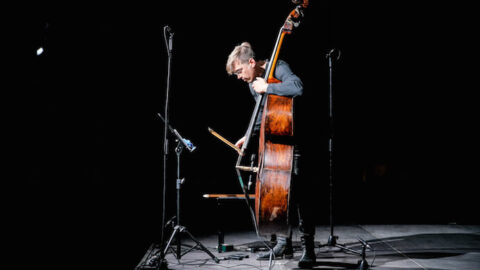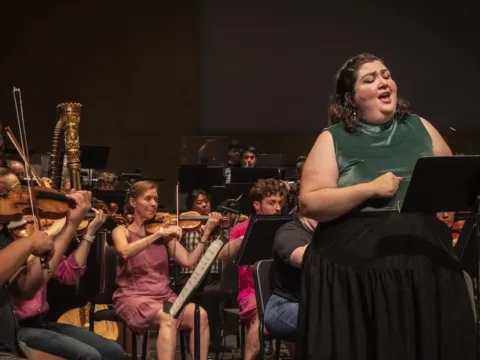The yearly International Festival of Contemporary Music staged by La Biennale di Venezia opened its first weekend on September 28-30, 2018 with a focus on Frank Zappa, Elliott Carter and solo double bass–But how much double bass can humankind endure?
Zappa’s The Yellow Shark
Descending from the stage into the hall of Teatro Goldoni vocal artist David Moss invited a lady in one of the front rows to dance. Cheered on by the audience, they happily whirled around, but Moss when exhorted all to take suit in a polonaise through the baroque entourage of the Venetian theatre, only one of the musicians joined in. In a train of two, they remounted the stage, where conductor Tonino Battista and his Parco della Musica Contemporanea Ensemble (PMCE) were visibly having the time of their lives.
They just presented the Italian premiere of the integral version of Frank Zappa’s The Yellow Shark in the opening night of the 62nd International Festival of Contemporary Music of La Biennale di Venezia. The theme of this edition is ‘Crossing the Atlantic,’ with a focus on musicians and composers from both the Americas and the Old Continent. Zappa fits in perfectly, since he composed this 70-minute suite for the German Ensemble Modern shortly before his death in 1993.
In the improvised overture, the musicians flared up in comical outcries that were in sharp contrast with the ominous dark electronic drones from the synclavier. One musician hooted through an alphorn, the mandolinist played a reference to ‘O sole mio,’ while David Moss made a yellow carbon shark ‘ride the waves’ onstage from left to right.

In the remaing hour, PMCE veered from oom-pa-pa-jazz in ‘Dog Meat’ to Webernian aphorisms in ‘Questi Cazzi di Piccione,’ and Stravinskyan driving rhythms in ‘Pound for a Brown.’ Moss gave a hilarious interpretation of ‘Welcome to the United States,’ jabbing a stick at the questions on a flipover that prospective immigrants must answer before entering the US. When possible diseases were mentioned, the ensemble started coughing furiously, when Moss enquired after possible arrests, all hands flew up simultaneously.
The Venetians loved it, but I’m not sure whether Zappa would have appreciated this carnivalesque approach. Of course, his texts are scathingly ironic, but he addresses serious themes such as food shortage, environmental pollution and the fear of foreigners. These issues have become all the more poignant since the inauguration of president Trump, who denies climate change and openly scorns non-white people. Due to all the frolicking, the earnestness of his message was obscured. Shame, too that PMCE proved not to be on a par with Ensemble Modern: the intonation was somewhat insecure, the timing uneven.
Tribute to Elliott Carter
Sadly, the recital of Keith Jarrett, awarded the Golden Lion for Lifetime Achievement, was cancelled due to health problems. Instead, the festival presented a tribute to Elliott Carter on the evening of September 29th, the PMCE performing three of Carter’s works in Teatro alle Tese. This forms part of L’Arsenale, the first industrial site in the world, where the Venetian Admiralty produced ships at the rate of one bark a day. The bare bricks beautifully resonated with Carter’s modernist notes. Pianist Lucio Perotti and oboist Fabio Bagnoli were competent soloists in Dialogues for piano and ensemble and Carter’s Oboe Concerto respectively.

Florentin Ginot
Earlier that Saturday, the French double bass player Florentin Ginot gave a solo recital in the adjoining hall, playing four Italian premieres in a theatrical setup. Four dimly lit double basses were mounted on as many stages. Ginot climbed the highest podium to a large, 5-string double bass, his iPad with the score of Rebecca Saunders’ Fury positioned at his feet.
Though Saunders wrote Fury in 2005 and it was already released on CD, this was its first performance in Italy. Ginot is a very accomplished player, producing a palette of sounds ranging from hellishly low grindings, ferocious metallic shrieks, percussive slaps, and ear-piercing pizzicati to hesitant lyrical lines, seductive mewings, and deeply resounding harmonies.
For the next piece, Table of Knowledge, Liza Lim was inspired by psychotropic plants. She extends the expressive range of the double bass using a simple yet effective Vietnamese technique that allows the performer to produce overtones with his mouth, while simultaneously playing his instrument. Thus, Ginot created a kind of ghost choir that enveloped the regular sounds of the bass like a halo. After the concert, I asked Lim to explain this technique.
Next was the short but effective Obstinate by Georges Aperghis, in which he underpins low gruntings and fast figurations with loud rhythmic breaths. Pièce de résistance was the world premiere of We Must by Sebastian Rivas, a twenty-minute tour de force for double bass and electronics. Bowing the tuning screws of the 5-string bass, Ginot created ephemeral sounds modulated by the live electronics.
Rarefied harmonics rose up and dissolved into inaudible heights, a crackling fire seemed to come from somewhere outside the hall. A sudden smacking sound catapulted an orgy of sounds that threatened to drown us. Flashing lights jumped over the four double basses while a taped voice recited texts from Shakespeare’s The Tempest. ‘Be not afeard, the isle if full of noises.’ After a passage on the reclining 4-stringed bass using only his hands, this striking piece ended with the phrase ‘Let your indulgence set me free.’
Charlotte Testu
On Sunday afternoon, Charlotte Testu played four pieces in Sala delle Colonne, a hall in the headquarters of the Biennale near San Marco Square. The works all relied heavily on electronics, but the most effective was Radio Bass by the Brazilian composer Aurélio Edler-Copes, commissioned by the Biennale. In 8 short movements Edler-Copes leads us through an amazing sound world in which an extremely low computerized voice competes with babblings, shouts, and whisperings by Testu. Meanwhile, she extracts a plethora of stampeding, sizzling, melodious, and grunge-like sounds from her instrument. After some 20 minutes of havock, the computer voice concludes with a ‘thank you for your interest in this radio bass.’

Dario Calderone
The evening concert was dedicated to yet another commission from the Biennale, performed by double bass player Dario Calderone in the Sala d’Armia at L’Arsenale. After all the aggressive, distorted sounds the composers had in store for Testu, Giorgio Netti‘s Due riti offered a haven of tranquility. A microphone on the body of the instrument picked up every subtle nuance of Calderone’s performance. Like Ginot and Testu, he’s a very accomplished and intense player.
For minutes on end, he bowed the strings in repeated long-held notes, exploring his instrument in utmost quietude. Sharp metallic tones, violent slaps, and rattling noises alternate with subtle pizzicati, soft glissandi, and celestial harmonics. In the second movement, Calderone changed to a bow that was directly connected to the sound mixer in the back of the hall. The overall sound became more percussive, but there was no dramatic difference with the material that went before and the audience started fidgeting. Indeed, the hour-long performance of the Due riti was quite a challenge.
In any case, the question arises of how much double bass ‘humankind can bear,’ to paraphrase T.S. Eliot. It’s a laudable idea of festival director Ivan Fedele to extend the repertoire for this instrument, but three consecutive solo concerts is perhaps a trifle too ambitious. Fortunately, the 62nd International Festival of Contemporary Music of La Biennale di Venezia had many other concerts in store, with the presentation of 11 one-act-operas on the closing evening as a highpoint to be looked forward to.
























